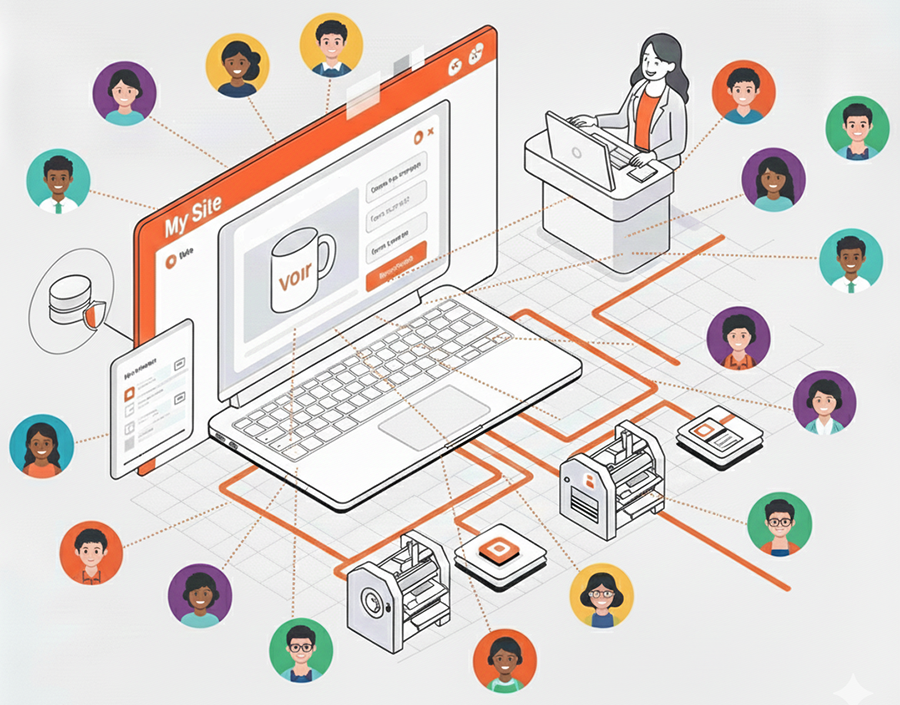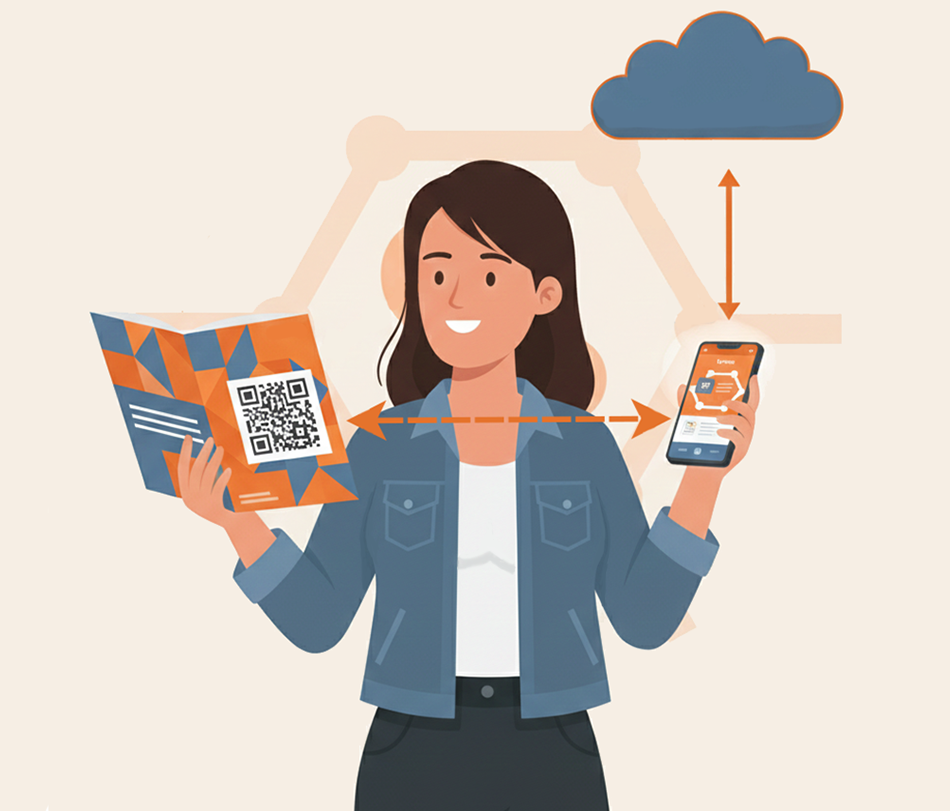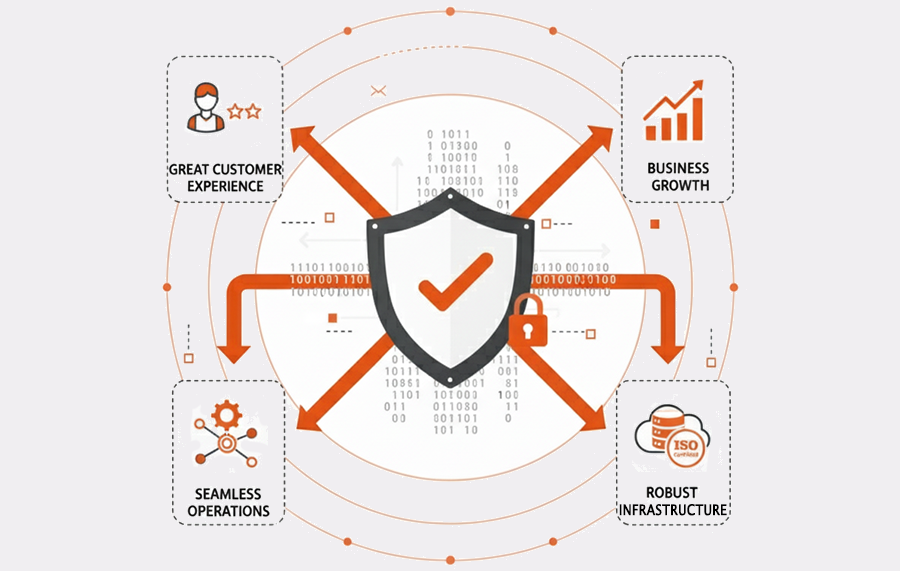23 June 2025
Procurement User Interface (UI) is Essential for Selling Print Online in a 24/7 Market
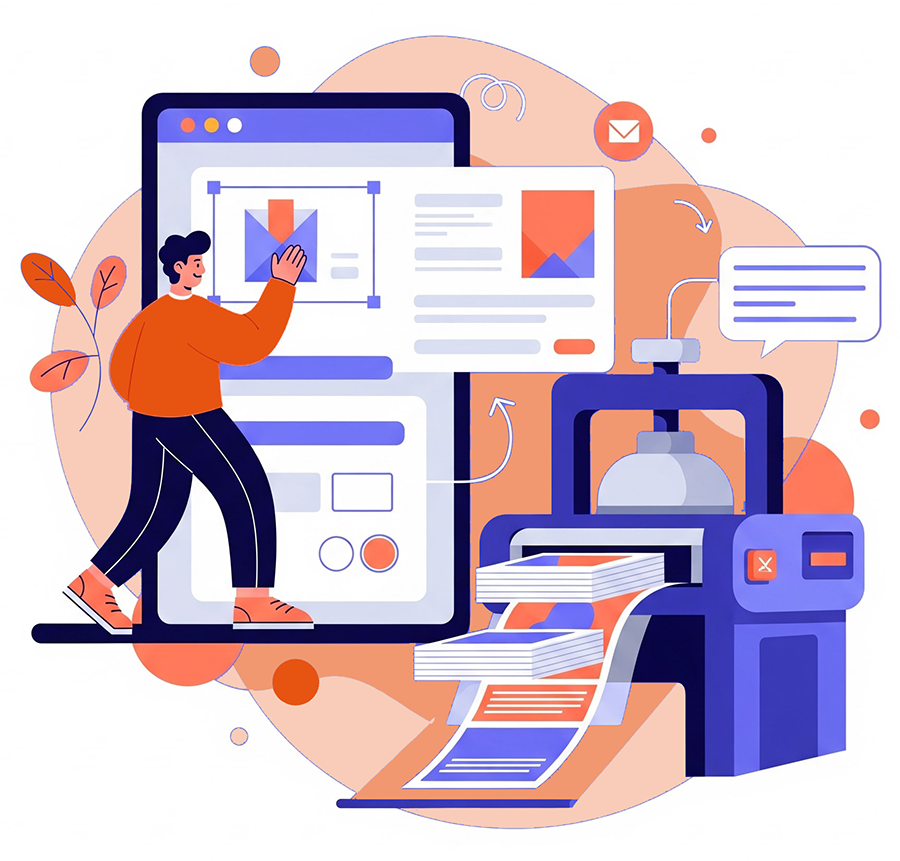
Procurement User Interface (UI) is Essential for Selling Print Online in a 24/7 Market
In today’s fast-paced and 24/7 market, having a robust online presence is no longer a luxury—it’s a necessity, especially for print service providers (PSPs). A web-to-print storefront is more than just an online ordering system; it’s a comprehensive solution that seamlessly integrates your print business into the digital landscape.
This platform empowers customers to personalise, configure, order, and manage their print products effortlessly, saving time and boosting customer satisfaction. With good web-to-print software, you need to be able to create an intuitive and user-friendly storefront that streamlines the ordering process. This not only helps grow your business but also positions you as a forward-thinking and customer-centric PSP.
However, success in web to print storefronts goes beyond functionality—it hinges on the user experience. In an era of increasingly sophisticated digital interactions, the importance of a well-designed User Interface (UI) cannot be overstated.
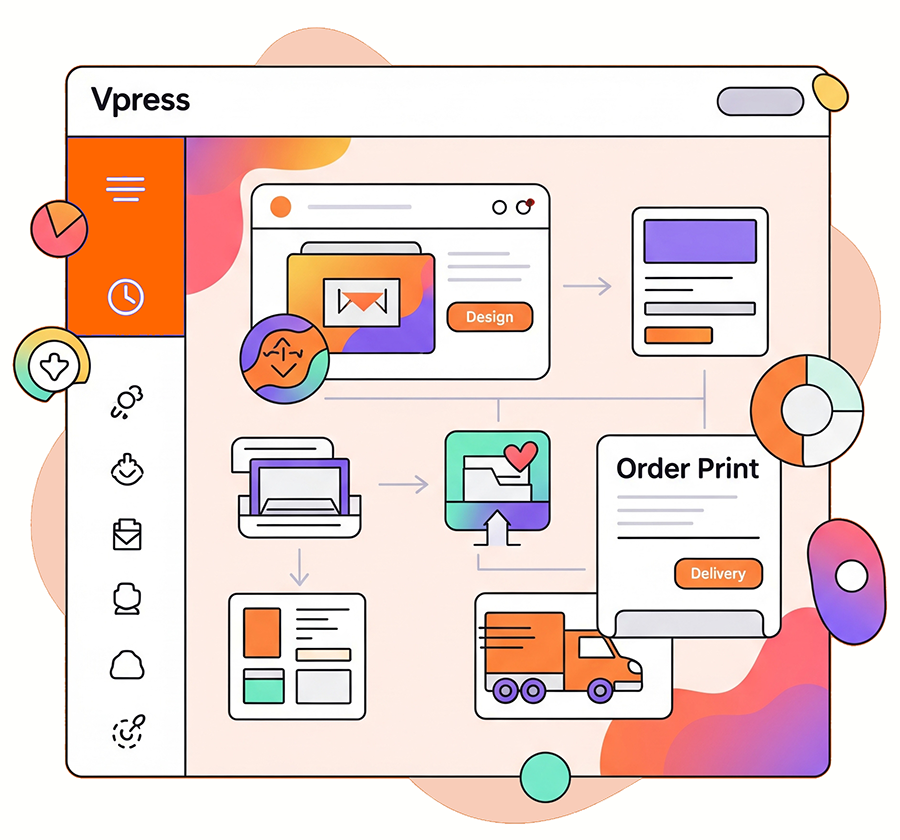
A good UI makes the difference between a valued customer and a frustrated one. By prioritising UI, PSPs can transform their online print commerce and elevate their business to new heights.
Seamless Sales: Why Print Needs a Strong UI
In today’s digital-first economy, the way people purchase goods and services has evolved dramatically. Just look at other markets transformed by businesses like Amazon. Consumers now expect seamless, around-the-clock access to products — and the print industry is no exception.
Whether it’s business cards, point of sale (PoS), promotional materials, or complex custom jobs, buyers are increasingly turning to online platforms, such as web-to-print or print on demand, to fulfil their print needs on their own schedule.
For companies selling print and print-related materials, this shift presents both a challenge and an opportunity. The challenge lies in translating what is often a complex, customised, and traditionally consultative product into an intuitive online experience. This involves more than just listing products; it requires creating a platform capable of handling the nuances of print customisation — from design to ordering — in a user-friendly manner.
The opportunity, however, is significant. By empowering customers with a robust procurement user interface (UI), print sellers can meet their customers where they are — online, and at their convenience.
A well-designed UI can simplify the ordering process, provide real-time previews, and offer a seamless experience that mirrors the ease of other online shopping platforms. This not only enhances customer satisfaction but also drives engagement, educates buyers, and ultimately boosts sales.
In this blog, we’ll explore why a dedicated web to print UI is essential for the modern print seller. We will delve into how effective functionality can streamline the ordering process, reduce errors, and make the entire experience more enjoyable for the customer.
By understanding the importance of a user-centric UI, print businesses can leverage this technology to stay competitive and thrive in the digital age.
The Changing Landscape of Print Procurement
Print procurement has undergone a significant transformation in recent years, shifting away from the traditional model of face-to-face interactions, phone calls, and wet or PDF proofs. In the past, salespeople played a central role in consulting with clients to define specifications, provide quotes, and guide them through timelines and production processes. However, this model no longer aligns with the expectations of today’s fast-paced, digitally enabled buyers.
Modern buyers demand a different kind of experience. They want instant access to product options and pricing, enabling them to make informed decisions quickly.
Self-service capabilities have become essential, reducing reliance on salespeople and empowering buyers to manage their own purchasing process. Transparency is also vital, with buyers seeking clear information on customisation options, shipping details, and turnaround times.
Additionally, they expect control over the purchasing process, available 24/7, to fit their busy schedules and preferences.
A good Web-to-Print UI that allows users to explore, configure, and purchase print products at any time is no longer a luxury — it’s a necessity. This shift towards digital procurement is driven by broader trends in digital transformation, where businesses are adopting technologies like AI, automation, and cloud services to enhance efficiency and customer satisfaction.
In this evolving landscape, print service providers must adapt to meet these changing demands. By offering a robust and intuitive online print storefront, businesses can deliver the seamless, self-service experience modern buyers expect.
This not only improves customer satisfaction but also positions the print business for success in a highly competitive and rapidly changing market.
What Is a Procurement User Interface?
A procurement user interface is a digital platform or portal that enables buyers to browse, customise, quote, and purchase goods — in this case, print and related products — entirely online. Think of it as a self-service dashboard that merges eCommerce functionality with business-specific purchasing tools.
For the print industry, Web-to-Print or Print OnDemand solutions exemplify this concept, offering a seamless online print ordering experience.
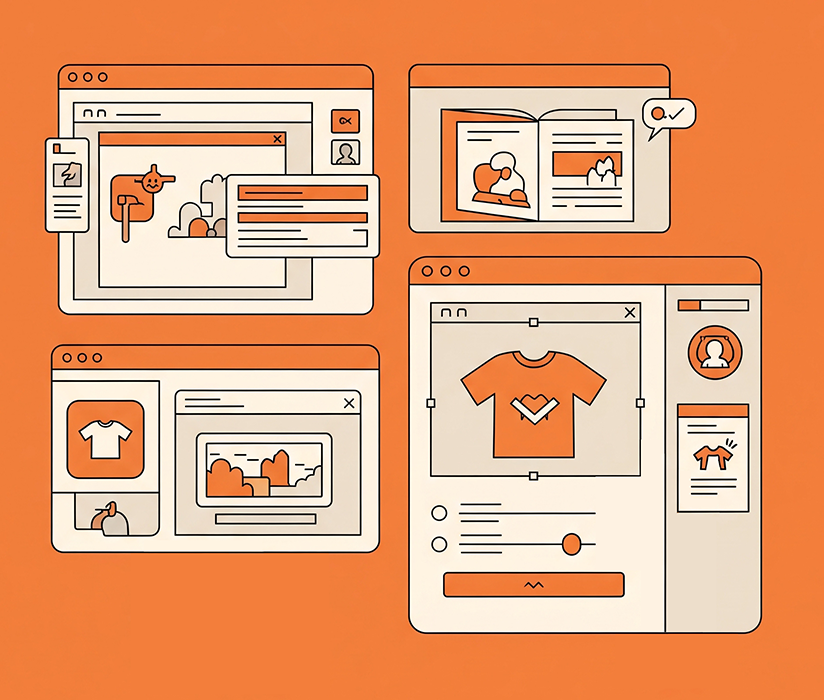
This interface is more than just a transactional tool; it serves as a way to engage with your customers, fulfilling their expectations while helping you achieve your sales and efficiency goals. A strong procurement UI within a Web to Print solution should include several essential features.
- A product catalogue with dynamic customisation options is fundamental. This allows customers to personalise their print products according to their specific needs, such as selecting different materials, colours, or designs. This level of customisation enhances the user experience and ensures customers can find exactly what they are looking for.
- A robust pricing engine is also essential, as it must reflect the complexities of print production. This engine should calculate prices in real-time based on factors like the type of print, quantity, and any custom features selected by the customer. This transparency helps build trust and ensures customers are fully aware of all costs upfront.
- Order history and tracking are critical components of a procurement UI. These features empower customers to view their past orders, track the status of current orders, and manage their accounts efficiently. This level of visibility and control is key to maintaining customer satisfaction and loyalty.
- Support for bulk ordering and account-specific pricing is another vital feature. This functionality caters to business customers who often place large orders and require special pricing arrangements.
By integrating these features, a procurement UI can effectively address the needs of both individual and corporate clients.
Finally, educational content should be readily available to guide less experienced buyers through the process. This could include tutorials, FAQs, and other resources that help customers understand the various options and processes involved in ordering print products online. By offering this support, you ensure that all customers, regardless of their expertise level, can navigate the system with ease.
Why It Matters for Print Sellers
Investing in a Web-to-Print solution is important for print sellers, and here are several key reasons why it is so significant.
24/7 Accessibility Meets Modern Expectations
Customers today expect round-the-clock access to services. A Web to Print solution ensures your business is available to meet these modern expectations, whether it's for time-sensitive orders or last-minute jobs. This accessibility aligns with the autonomy buyers want, allowing them to research, customise, and complete purchases at their convenience — without waiting for callbacks or emails. Whether you cater to B2B or B2C customers, providing a responsive and user-friendly experience positions your business as a competitive choice.
Complexity Made Simple
Print products can be inherently complex, with numerous variables like paper types, weights, finishes, folds, and bindings. A well-designed Web-to-Print solution simplifies this complexity with interactive tools, guided configurations, and intuitive UI. This reduces friction for customers, especially those who aren’t print-savvy, and builds confidence in their choices. By streamlining the buying process with visuals, tooltips, and user-friendly portals, you create a seamless experience that resonates with both first-time and repeat buyers.
Educating the Buyer Builds Trust
Trust is built through education. A smart Web-to-Print interface integrates educational tools like FAQs, guides, and calculators to help customers understand their options, costs, and the terminology behind the print process. This fosters informed decisions, reduces uncertainty, and enhances customer satisfaction. By addressing common questions and offering visual explanations, you not only upsell products but also cultivate long-term relationships with buyers who feel confident and valued.
Improved Efficiency for Both Buyer and Seller
Efficiency is key for both buyers and sellers. Web to Print solutions automate sales processes, streamline workflows, and reduce manual errors, saving significant time for your team. This allows designers and sales teams to focus on high-value activities rather than basic order processing. Automated systems also enhance order submission, improve customer service, and reduce operational delays, making your business more agile and cost-effective in a competitive marketplace.
The Cost of Doing Nothing
Still relying on quote requests and ordering via email or phone? You're likely missing out on a huge segment of the market. In today's digital age, not adopting a modern Web-to-Print solution can have significant consequences for your business.
Without a Web-to-Print solution, you are unavailable when your customer is ready to buy. The 24/7 nature of online shopping means that customers expect to research, customise, and purchase products at any time. If your business is not accessible during these hours, you risk losing potential customers to competitors who offer round-the-clock service.
This traditional approach also creates friction or barriers that can send buyers to your competitors. The manual process of sending PDFs and awaiting quote requests can be cumbersome and time-consuming, leading to frustration and a higher likelihood of customers seeking alternatives that offer a smoother, more efficient experience.
Failing to educate your customers is another significant drawback. Without an interactive and informative Web-to-Print interface, customers may not fully understand the options available to them or the reasons behind certain costs. This lack of education can lower conversion rates, as customers may feel uncertain or overwhelmed by the complexity of the print ordering process.
Moreover, not having an online Web-to-Print solution reduces operational efficiency and increases your costs compared to competitors. Manual processes are more prone to errors, require more labour, and slow down the entire workflow. In contrast, automated Web-to-Print solutions streamline the ordering process, reduce administrative burdens, and enhance overall efficiency, allowing your business to operate more cost-effectively.
In short, not having an online Web-to-Print solution isn't just outdated — it's risky. It can lead to lost sales, reduced customer satisfaction, and higher operational costs, ultimately putting your business at a competitive disadvantage in the market.
Real-World Success Stories
Many forward-thinking print businesses have already embraced advanced Web-to-Print solutions, and their success stories are truly compelling.
Business-to-consumer (B2C) Companies at the forefront of this shift have implemented user-friendly interfaces (UIs) that empower customers to easily configure, preview, and order printed products with minimal effort. This seamless experience is not only revolutionising B2C transactions but is also making significant waves in the business-to-business (B2B) space.
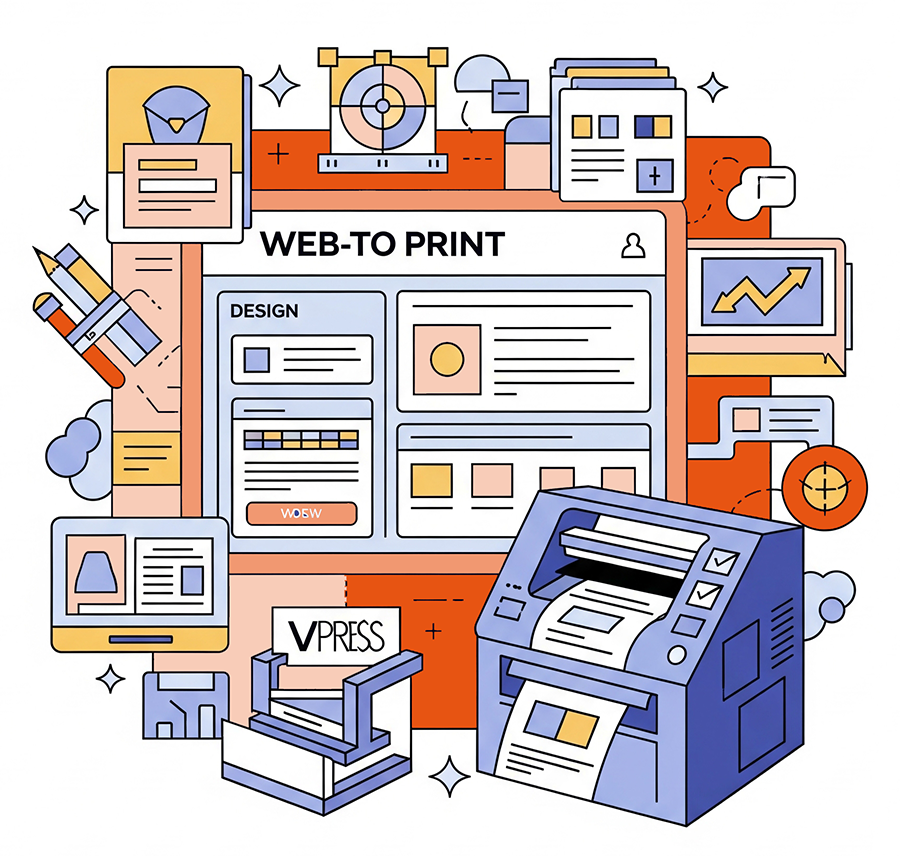
In the B2B sector, companies like Vpress are setting new benchmarks with their Coreprint solution.
Vpress’ Coreprint Web-to-Print storefront provides deep control over the system's user experience. Admins can configure the look and feel of their portal, allowing granular control over layout and navigation for a personalised and efficient interaction. Simultaneously, administrators can tailor the UI/UX of the entire platform, customising workflows and features to perfectly align with the unique procurement needs of each of their customers. This ensures every client enjoys a highly relevant and streamlined journey within the print ordering solution, fostering long-term relationships and boosting customer satisfaction.
These tools don’t just meet expectations—they exceed them by establishing higher standards for what customers can expect from their print service providers.
Vpress continues to innovate, introducing exciting new features to their Coreprint Web-to-Print UI. These advancements are designed to not only enhance the user experience but also support production workflow efficiencies within the print supplier's operations. By integrating such advanced functionalities, Vpress is helping print businesses optimise their operations and deliver exceptional customer experiences.
If you're interested in learning more about these innovations and how they can benefit your business, connecting with Vpress can provide valuable insights into leveraging these tools effectively.
Conclusion
In conclusion, incorporating a robust Web-to-Print solution with a user-friendly interface is no longer a luxury, but a necessity for print service providers. This technology ensures 24/7 accessibility, simplifies complex print ordering, and educates buyers, thereby enhancing customer satisfaction and trust.
The Vpress Coreprint system isn't just about streamlining operations and cutting expenses; it's about building bridges to deeper, more lasting customer loyalty. Our customers are consistently reporting outstanding results, transforming their businesses by giving their clients the ultimate in barrier-free print ordering.
To stay competitive and thrive in the digital age, it is essential to adopt a Web-to-Print platform that meets modern buyer expectations. Take the first step today and transform your print business for the better.
Ready to Transform Your Business?
Thousands of successful businesses have transformed their operations—yours can too. Begin your journey today with our powerful Web-to-Print solution
Frequently Asked Questions
What is a web to print procurement user interface and why is it essential?
A web to print procurement user interface is a digital platform that enables buyers to browse, customize, quote, and purchase print products entirely online, 24/7. It's essential because modern buyers expect instant access to product options, self-service capabilities, and transparent pricing without waiting for sales representatives. This interface combines eCommerce functionality with print-specific tools like dynamic customization options, real-time pricing engines, and order tracking, making complex print ordering simple and accessible anytime.
How does a web to print UI simplify complex print ordering processes?
A well-designed web to print UI simplifies complexity through interactive tools, guided configurations, and intuitive navigation. It handles numerous variables like paper types, weights, finishes, folds, and bindings by presenting them in user-friendly ways with visual previews, tooltips, and step-by-step guidance. This reduces friction for customers who aren't print-savvy, builds confidence in their choices, and transforms what was traditionally a consultative process requiring phone calls and PDFs into a seamless self-service experience.
What features should a modern web to print storefront include for B2B customers?
A modern web to print storefront for B2B customers should include a dynamic product catalogue with customization options, a robust pricing engine that handles account-specific pricing and bulk orders, comprehensive order history and tracking capabilities, support for multiple user accounts with different permissions, approval workflows for purchase orders, integration with procurement systems, and educational content like FAQs and guides. Advanced features like granular UI/UX control allow businesses to tailor the experience to each customer's specific procurement needs.
How does implementing web to print software improve operational efficiency for print service providers?
Web to print software dramatically improves operational efficiency by automating sales processes, streamlining workflows, and reducing manual errors. It eliminates time-consuming tasks like phone quotes and email orders, allowing design and sales teams to focus on high-value activities. The automation reduces order processing time, minimizes data entry errors, provides real-time inventory management, and enables 24/7 order intake without additional staff. This results in lower operational costs, faster turnaround times, and the ability to handle more orders with the same resources.
What are the risks of not having a web to print solution in today's market?
Not having a web to print solution poses significant risks including lost sales when customers can't order during off-hours, losing business to competitors who offer 24/7 online ordering, creating friction with manual quote processes that frustrate modern buyers, missing opportunities to educate customers about product options and value, higher operational costs due to manual processing, increased error rates from phone and email orders, and inability to scale efficiently. In today's digital-first economy, operating without web to print technology puts print service providers at a serious competitive disadvantage.
Procurement User Interface (UI) is Essential for Selling Print Online in a 24/7 Market
Table of contents
Share this article
